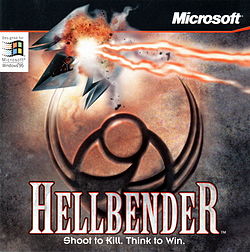- Hellbender (video game)
-
Hellbender 
Developer(s) Terminal Reality Publisher(s) Microsoft Platform(s) Windows 95 Release date(s) December 12, 1996 (US) February 19, 1998 (UK)
Genre(s) Flight simulator Mode(s) Single Player/Multiplayer Rating(s) ESRB: K-A Media/distribution CD-ROM System requirements 8MB of RAM 32MB available hard disk space Windows 95
Hellbender is a PC video game developed by Terminal Reality in 1995–1996 and released by Microsoft in 1996, as the sequel to Fury3. A demo version of the game was included on later CD-ROM versions of Windows 95.
Contents
Gameplay
Hellbender features similar gameplay to Fury3 and Terminal Velocity (and is a sequel to Fury3)[1]. The player is in control of a prototype spacecraft (the "Hellbender") and must fly it around a map, destroying various targets and reaching checkpoints. There is a large selection of weapons available, including the Valkyrie cannon and the Sledgehammer rocket.[2] Many more weapons are available by collecting power-ups during gameplay.
The levels in Hellbender are composed of a few missions that take place on eight different planets. There are typically three missions per planet.
Plot
Six years after the events depicted in Fury3, the Bions (an alien race created by Earth scientists which rebelled and became ruthless killing machines) kill all the Coalition's qualified pilots on Sebek.[3] The player's character ("the Councilor") is the last surviving pilot for the Coalition of Independent Planets, the defense group that protects Earth from the Bions. The Bions are now targeting the rest of the Coalition's citizens. The pilot must accomplish various objectives on eight different worlds in order to stop the Bions, save Earth, and win the game. The storyline is a continuation of the storyline from Fury3.
See also
References
External links
Terminal Reality Games Terminal Velocity • Fury3 (F!Zone ) • Hellbender • Monster Truck Madness (MTM2 • MTM64 • Advance) • CART Precision Racing • Nocturne (Rustin Parr) • Fly! (2K • II) • 4x4 Evolution (EVO 2) • BloodRayne (2) • RoadKill • BlowOut • Æon Flux • Spy Hunter • Ghostbusters • Def Jam RapstarTechnology Publishers 3D Realms • Microsoft Games • Gathering of Developers • Majesco • Midway Games • SNK Playmore • AtariRelated companies Key people Categories:- 1996 video games
- Microsoft games
- Science fiction video games
- Video game sequels
- Video games developed in the United States
- Windows games
Wikimedia Foundation. 2010.
